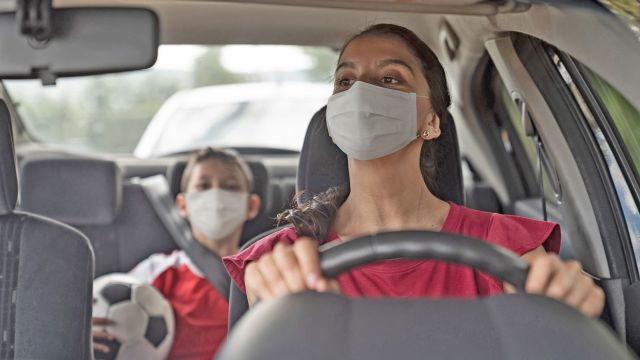Updated on August 20, 2020.
While back-to-school protocols and preparations have captured the attention of most American families, many kids are also itching to resume playing their favorite sports.
The benefits of organized play are many: In addition to the improved cardiovascular fitness, stronger immune function and improved mental health that physical activity provides, team play fosters socialization and camaraderie, which many kids have missed out on during the pandemic.
But can school and recreation leagues return to the field safely in the time of COVID-19?
“We want our children—and adults, too—to remain active,” says Keri L. Denay, MD, lead author of the American College of Sports Medicine’s “ACSM Call to Action Statement: COVID-19 Considerations for Sports and Physical Activity” and director of the Sports Medicine Fellowship in the Department of Family Medicine at the University of Michigan Medical School in Ann Arbor. “Participation in sport needs to have a creative and flexible approach at this time.”
As with other activities, youth sports requires taking essential precautions as a baseline. That means following social distancing, wearing masks and practicing good hand hygiene, plus a few more specific to the setting. Here are some factors to consider when determining whether to sign up your child for their sport of choice.
Take a personal risk assessment
It’s important to contemplate whether it’s safe to introduce your child to a group setting. Start by considering your child’s health.
“Some children may be at higher risk of COVID-19, such as those who are immunosuppressed or have underlying medical issues, such as asthma,” Dr. Denay says. “It’s important to note that the effects of COVID-19 can and do affect those with no underlying medical conditions, as well.”
If your child has tested positive for COVID-19, is showing any symptoms or has recently been in contact with anyone infected with the virus, take one for the team and stay home. (The same calculation applies to coaches and those who will be in close proximity with players.) If your child has contracted COVID-19 and recovered in the past, check with your pediatrician on whether it’s safe to return to physical activity.
You should also consider the risk factors of members of your household who would come into contact with your player. Older people and anyone with health conditions including heart disease or diabetes are also at increased risk for complications from COVID-19.
Know the rates in your area
Check with your state or local health department for information on the community spread of COVID-19 in your area. The more widespread the disease in the place you live, the higher the risk of getting sick if you or your kids gather with others.
“If the numbers are high, this should suggest an increased risk for coaches, athletes and parents when they are away from the practices or events,” says Shane Stecyk, PhD, a professor in the department of kinesiology and director of the Athletic Training Program at California State University, Northridge. “If numbers are very low, then the risk during competition should be low as well.”
Consider the sport
When it comes to risk of COVID-19 transmission, not all sports are created equal. Whether the sport allows for social distancing should be top of mind. Distance is easier to achieve in games like tennis, golf, softball or baseball. Wrestling, basketball, football or soccer, on the other hand, naturally bring players into contact with each other.
“The closer the competitors, the greater number of competitors and the more physical contact, the greater the risk,” Stecyk says.
That doesn’t necessarily mean that contact sports are a non-starter, but they will likely need to be modified. “Unfortunately, during this time, high-risk sports such as wrestling and football may need to have competition delayed while focusing instead on individual skills and cross-training to ensure the health and safety of those athletes,” says Denay.
The Centers for Disease Control and Prevention (CDC) advises that coaches skip full-team scrimmages during practice and instead divide teams into small groups that cycle through specific skill stations. If the game must go on, the CDC recommends limiting contact play to game situations only and decreasing the number of matchups played during a season.
The reality, according to Stecyk, is that certain sports can only be modified so much. “You can't have football linemen physically distance and you can't tackle from 6 feet away from your competitor,” he notes. “I think we need to look at the bigger picture: If we are going to modify a game to such an extent, could all of that effort, time and money be better directed to having parents provide physical activity family time to maintain fitness and mental health?”
Think about where the game is played
“Outdoor, low contact sports are the lowest risk as it pertains to COVID-19 transmission,” says Denay. Being outdoors is generally preferable to indoors because the airflow is better, enabling particles of SARS-CoV-2—the virus that causes COVID-19—to disperse more effectively.
For indoor venues, the CDC advises circulating outdoor air as much as possible by opening doors and windows and making sure that ventilation systems are working properly.
In a perfect world, your child’s team could face opponents in a controlled bubble at Walt Disney World Resort, the way the NBA is conducting this season. In the real world, youth teams may have to travel for games. You can’t control the social distancing or masking practices of other teams, but it is worth considering signing up for a league that only plays against teams in your neighborhood, town or community.
“Travel is a controversial topic,” Denay says. “Most experts would agree to limit travel to none or to local areas only at this time to decrease risk of transmission and spread of the virus.” One of the cherished traditions of travel ball—the team carpool caravan—may have to change, as well. The CDC advises that players ride to events only with people from their own household to reduce risk.
Ask what is being done to ensure safety
Your team or league should have a set of protocols in place before practices or games begin. Some of the things you should look for include:
Designated point persons: “Coaches and league administrators need to have a very clear communication system,” Denay says. Each team should consider assigning one person the job of communicating with league staff, coaches and families about all matters relating to the virus to help streamline the flow of information.
The CDC also recommends that youth sports programs designate a staff person to respond to any COVID-19 concerns from coaches, league staff and families.
Clear guidelines: Your league or team should establish and communicate ground rules for players and parents to follow. This should include protocols about masks, hand hygiene and the expectation that players will stay home if they are sick or have had contact with others who are.
Teams may also assign to parents the responsibility of keeping players apart when they’re on the sidelines. This is especially important for younger players who may not be as skilled at social distancing as older players are. You may also be asked to drop your players off at specific times to help keep them from congregating in groups before practices or games begin. Players may need to wait in the car or away from fields until the start time.
Whatever the particulars of your league’s or team’s rules, make sure they are articulated clearly before the season starts so that all families begin with the same set of expectations.
Minimized sharing of equipment: Though the main mode of transmission of COVID-19 is believed to be close contact with an infected person, the CDC notes that it is possible for a person to become infected by touching an object that has the virus on it, then touching their own mouth, nose or eyes.
So, coaches and team parents should remind players—particularly younger ones—never to share personal items like water bottles, mouthguards or towels. Ideally, a team will acquire additional supplies to reduce the amount of sharing of communal items like bats and protective gear. When sharing is inevitable, some teams may assign parents the job of disinfecting items between each use.
Contingency plans in place: “The pandemic requires a great deal of flexibility and adaptability from everyone as information changes rapidly,” says Denay. To that end, leagues and teams should develop and communicate plans that would go into effect in case seasons need to be paused or cancelled due to community-wide or individual cases of COVID-19. “I recommend that these groups be in contact with their local health department for guidance and up to date information,” Denay adds.
Like so many aspects of life during the pandemic, athletics will be different. But with effort, patience and communication, kids can get back on the field to enjoy the community-building and fun that sports offer.






